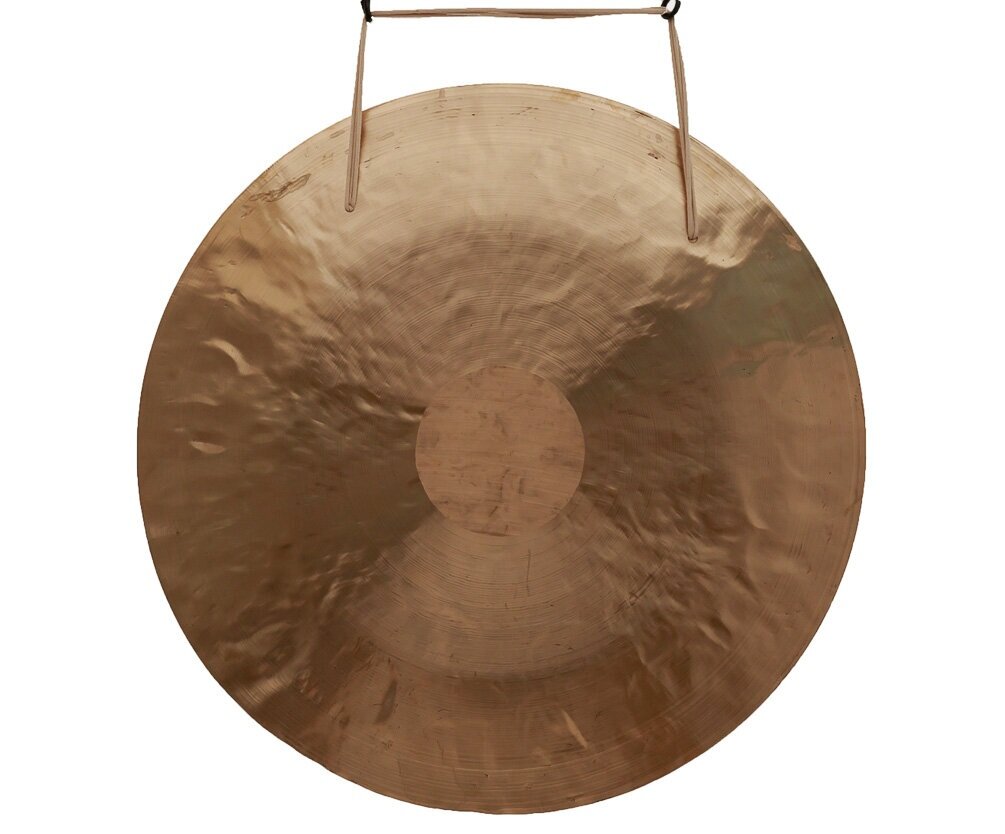china
CHAU GONGS
Probably the oldest lineage of gongs available today and probably the most numerous. he Chau (also spelt Chao) gong is very popular with the majority of the world’s symphony orchestras, especially in the United States, as well as some of the big name orchestras in Europe e.g. the Berlin Philharmonic. The Chau gong is instantly recognisable with its black or dark brown centre and colouring around the edge of the face of the gong, with a shiny gold coloured mid band separating the two. This patterning gives it another name – the Bulls Eye Gong. It is also referred to as a ‘Chinese’ gong by both Zildjian and Sabian and as a ‘Tam-tam Gong’ by Stagg.
The gongs are made from cast bronze to a formula of approximately 76% copper to 23% tin plus traces of zinc and iron. Being of cast construction, the gongs have a certain brittleness and will crack or shatter if dropped onto a hard unyielding surface. They are also very heavy. A 40″/100 cm Chao gong weighs 45 pounds (20 kg)! The sizes range from about 10″/25 cm to 72″/180 cm in diameter.
The sound characteristics of a Chao gong are what most people describe as ‘Chinese’. When struck piano, has a very strong fundamental note though some harmonics and overtones shimmer quietly over the top. When played forte or fortissimo, the crash is much more immediate with lots of overtones, but decays away very quickly.
For sound healers, the Chao gong makes a very good ‘Earth’ gong – the word ‘earthy’ describing the sound very effectively. They make good alternatives to the German Sound Creation Earth gongs and Symphonic Gong as they produce a wide range of tones and harmonics, though some would say they are less pure than the nickel silver Symphonic Gong.
Wind (Feng) Gongs
Another popular Chinese gong is the ‘Wind’ gong. It is sometimes also known as a ‘Feng' gong. The Wind gong is essentially a flat gong, though it can be slightly convex like a flat shield, or it can be flat across most of the face but with a very shallow slope at the edges. It has no rim. The gong is normally cast into a pancake shaped mass and then beaten very thin though there are rolled sheet versions. They are mostly made from B20 bronze though M63 brass is also used. They are fully lathed front and rear and are extensively hammered.
There is a moderate fundamental note but the main characteristics of this instrument are the washing overtones and harmonics, crashing highs and brilliant shimmer that give this gong its name – a rushing wind through the bamboo groves. The sizes available are 6″/15cm to 60”/150cm.
They are rarely seen in orchestras as the fundamental note does not penetrate enough and the crash can be a bit too trashy for symphonic works. Where these gongs have found a major following is in sound therapy, Feng Shui, space clearing, yoga and other ‘New Age’ practices. The portability of even the larger sizes (24″ to 32″) makes them easy to walk with and carry round various rooms of the house or around a person’s body, sounding the gong as you go. The cost is also a big factor in their favour when compared to Chau or Paiste gongs.
Hand Gongs
Hand Held gongs are small gongs normally held in one hand for playing. They are often associated with Chinese theatre and lion, dog and dragon dances. These gongs often look and sound very similar, with the diameter of the instrument resulting in a different name as well as the gong’s use in a certain piece of theatre or dance.
The sounds and tones for these gongs can be bright, clear and bell-like or crashy and warm like a tam-tam, or even a combination of the two.
There are two basic shapes. One has a flat central section with the rest of the face gently sloping down to a shallow rim. The flat central section varies in diameter and often has an effect on the gong’s sound character. The other has a flat face which turns over into a deep rim. All are made from bronze though there are some brass versions.
Examples of hand gongs include Tiger, Pasi, White, Smooth, Xiang Jin, Jia, Dan da, Night, Wu, Se etc. The most famous of the hand gongs are the ‘Opera’ gongs with their distinctive up or down ‘glissandi’ (sliding sound).
Bao gongs are ‘tuned’ gongs and have a raised central boss within a gently sloping face and a reasonably deep rim. They can be obtained fully lathed and polished, partially lathed (e.g. just the central boss), or unfinished with just the black copper oxide coating. They are made from cast bronze and are lightly hammered. They are offered in sizes from 11″/27cm to 24″/60cm in 5cm steps. There are also several designs. Some have a shallow valley towards the edge of the face before turning over into a deep 2″ to 3″ rim. The gongs are made from slightly thicker gauge metal that gives an overall bell- like sound with subtle overtones and a short decay, though not particularly musical. The gongs can be tuned to Western scales and ‘Dream Gongs and Cymbals’ offer a range of tuned gongs based on the Bao to order and are musically superior to standard Bao gongs from other manufacturers.

